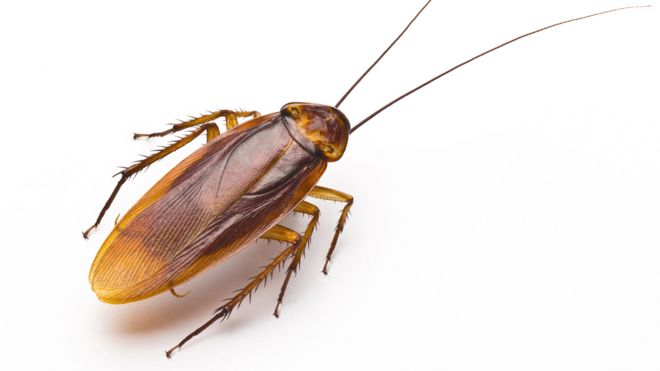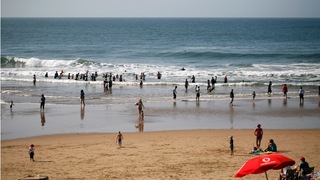Continuing the occasional series in which I record significant events from my life. This installment takes up a couple of months before the previous one ended.
For the first couple of weeks after Freda and Ian arrived, in September 1973, they joined me in the hotel which I had been staying in since my arrival. Soon we were offered a furnished house. A traditional colonial style bungalow with a tin roof and veranda, this cottage had been vacated by the owner who had a modern bungalow built at the back. At first it seemed quite romantic with its early twentieth century furnishings and decor. That was until the night Freda went into the kitchen to brew a nightcap – and screamed.
Anyone who knows anything about cockroaches will know that they hate the light. They come out to play after dark. If their playground is suddenly illuminated, by someone switching on a light for example, they scuttle back to their hiding places – in this case under the kitchen cabinets. “I’m not staying here,” was Freda’s verdict. When I explained the situation to the HR department, who passed it on to the owner, that lady insisted there were no cockroaches in her house, implying that we were impugning her reputation by suggesting such a thing. In that case, why were there several cockroach traps under various pieces of furniture? We wondered.

The company agreed to relocate us at the hotel for the time being. Construction, by a local developer, of a block of five terraced houses was almost complete and the company had taken a lease on two of them. One would be allocated to us. We were given an allowance to spend on furniture and textiles and told to visit an emporium in the inland town of Alexandria. “Ask for Smiley”, we were told.
“Smiley” turned out to be a very accommodating Indian gentleman and we selected beds, a settee and chairs, curtains and bedding from his overflowing warehouse. The day we moved in, the developer pointed out that a pair of Minah birds had constructed a nest in the eves. Should he remove it? No, we said. It would be a shame to disturb the birds, at least until after their young had fledged. Also, it would be interesting for Ian to watch the birds.
We got into the habit of doing our weekly shop on a Saturday morning in a new mall in the larger town of Amanzimtoti a few miles away on the road to Durban. We had become used to hearing the birds chatter but one Saturday, as we were having lunch after our shopping trip, they seemed especially noisy. “Those birds are inside,” Freda said.
“Don’t be silly, how could they get in?” was my response.
“I left the bedroom window open.”
With that she climbed the stairs – and, once again, screamed.
One of the birds had indeed come in through the window. Confused by the dressing table mirror, which was situated directly opposite the window, it had been trying to fly out of the reflected window. We succeeded in guiding it to the real window. There was now an awful mess to clear up.
All three of us developed itchy rashes which we put down to the change of climate. Several mornings we noticed accumulations of grit on the corner of the bath. Then one day I noticed that the ‘grit’ was moving. Once again we contacted the HR department and they sent along someone to have a look. “You have an infestation of bird lice,” was the verdict. “The birds’ nest has to be destroyed and the whole place fumigated.”
With the birds removed and the place fumigated we settled into a routine. The house was on a hill overlooking the estuary and the Indian Ocean, a view we never tired of. Ian was, by now in school. At that time in South Africa children did not commence school until they reached 7, unlike the UK where 5 was the usual starting age. At 8, Ian was therefore 2 years ahead of most of the children his age in the school and entered the 4th year alongside 10 and 11 year olds. Indeed, some were older because a grade system was in use which meant that children who failed to make the grade at the end of any year were held back. Ian, I’m glad to say, had no trouble keeping up, except with regard to the compulsory second language, Afrikaans.
Our son also joined the cub scouts. This was run by the wife of the factory’s Electrical Engineer, both of them German and both delightful to know. Over our time in South Africa we took part in various fund raising efforts for the Cubs and helped out at some events.
Before we knew, the spring of 1973 had metamorphosed into summer, the highlights of which were Christmas and New Year celebrations. These included an outdoor Christingle service on the village football ground and a factory Christmas party at which a group of the African labourers entertained us with their “Gumboot Dance”, a traditional African stomping dance performed in Wellingon boots.
By then the house next door to us had been let to a young couple. The husband was a Welsh Chemical Engineer. Having begun his career in one of the steel mills in South Wales, he had emigrated to South Africa to work for the South African Steel Corporation (SASCOR). From there he had moved to SAICOR with his Dutch wife. For clarity, when I say “Dutch” I mean that she was born in Holland, not that she was a South African of Dutch descent. As a new employee he was provided with temporary accommodation whilst he awaited the construction of his own house in the company’s staff village. This was an area of land owned by the company where employees could purchase a plot and have a house built to their own specification.
They brought with them twin boys about 2 years old, both as blond and pale skinned as their mother and each determined to play with the other’s toy despite having his own identical copy! The poor woman was forever having to break up fights between them, or so it sometimes seemed. To be fair, they were a delightful family and we quite often “babysat” for each other.
The summer climate was extremely hot and humid – or seemed so to us being more used to the British climate. Days would usually begin very hot with clear skies and brilliant sunshine. In the afternoon clouds would appear and the atmosphere would become very oppressive. There were frequent thunder storms with torrential rain in the late afternoon and early evening. One consequence of this was that the ocean in the vicinity of the estuary became red with the soil being carried down river from cultivated lands in the hills above.
The other feature of the portion of ocean visible from our windows was a long line of white surf about a mile off-shore. This, we learned, was a rocky outcrop known as the Aliwal Shoal. One Sunday, having taken Ian to a scouts’ event in a town a few miles down the coast, I noticed as we were traveling back without him, a tanker that appeared to be too close in. We stopped at a lay-by to take a closer look and it was obvious that the vessel was listing. Once back in Umkomaas we watched from our upstairs window as a couple of the ski boats operated by local fishermen journeyed to the stricken vessel to bring the crew to shore.

Ian was back in town in time to see the helicopter that landed to take the crew back to Durban. According to the newspaper the following day, the vessel was carrying molasses (raw sugar) from Mozambique. It had docked in Durban to refuel on the Saturday. It seems the Norwegian crew had a good night out in Durban and, after leaving the port on Sunday lunch time, had set a course due South before heading for their bunks, forgetting to allow for the Aliwal Shoal on their course.

I’m really enjoying this series of memories, Frank. Many thanks for sharing your interesting life with us. Looking forward to the next instalment 😊
LikeLike
I’m surprised but pleased that people actually enjoy reading about my unremarkable life! Thanks Clive and Sha’tara
LikeLiked by 1 person
I’m no psychologist but I can say this, that your history/story is human. It’s what we, the ordinary people, can relate to compared to the bullshit stories of celebrities, politicians and military men dumped on us day in, day out, and if it wasn’t for the damage they do to society, would be utterly meaningless. What’s wrong with “us” being the people we look up to, admire, or take lessons from? We need to look at one another and recognize that we are the people, not “they”, not “them”. My take on part of it. It’s like your story, “Transgression.” Even if it is fiction, it’s nevertheless real for us.
LikeLiked by 1 person
That’s fascinating reading, each new one better than the previous. Keep ’em coming Frank. And thanks for the entertainment.
LikeLike
Appreciated
LikeLike
Hahahahaha sorry to laugh at the cockroaches – but yes they are huge – we used to call them Durban Prawns – lovely stories
LikeLiked by 2 people
If you lived near Durban they were called Parktown Prawns! – Parktown being a suburb of Johannesburg.
LikeLiked by 1 person
Do you mean “lived near Johannesburg”, Lucinda?
LikeLiked by 1 person
Well I often wondered if each city was blaming the other – eg ‘We don’t have cockroaches the size of small ponies in our town!” They often feature in the Madam and Eve cartoons. If you’ve not seen those do Google them, they are hilarious.
LikeLiked by 1 person
The idea of relating them to prawns reminds me that they are seen in some cultures as acceptable food items – and someone somewhere is trying to sell a high protein flour made from dried and ground roaches https://munchies.vice.com/en_us/article/ezkeqm/meet-the-scientists-who-are-making-bread-with-cockroach-flour
LikeLiked by 1 person
Yes they have lots of protein in them. I quite liked mopani worms but only roasted. We’ll all be eating insects soon when they stop animal farming – once cows, pigs, sheep etc lose their usefullness to man they will be on the endangered list too – hey there’s a good blog post in that. But I don’t think many will stand up for insects om the loony left or right. 🙂
LikeLiked by 1 person
Great Article! Please check out my new article about South Africa – the 3 rondavels.
https://travelrahul.wordpress.com/2019/01/26/the-3-rondavels-south-africa/
Please like/follow me for more interesting content.
LikeLiked by 1 person
Nice pictures and beautiful golf course, but aren’t they all…
LikeLike
That cockroach, I die a thousand deaths when I see it!
It is the “ugh” factor of living in SA.
India has WHITE ones. Ugh again.
LikeLiked by 1 person